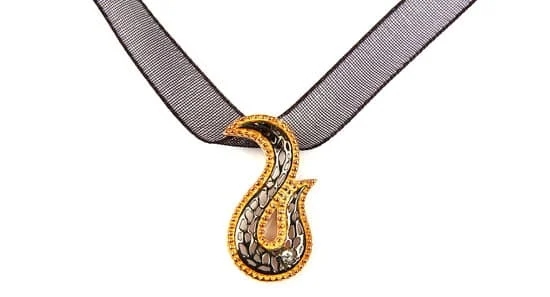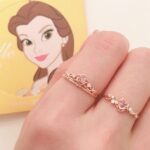What is the difference between jewelry and fine jewelry? When it comes to adorning ourselves, the terms “jewelry” and “fine jewelry” are often used interchangeably, but they actually refer to distinct categories with significant disparities. In this article, we will delve into the dissimilarities between these two classifications of adornments, shedding light on their unique characteristics and qualities.
Jewelry, in its broadest sense, encompasses any decorative items worn for personal adornment. This can include a wide array of pieces such as necklaces, bracelets, earrings, and rings made from various materials like metals, gemstones, beads, or glass.
Fine jewelry specifically refers to a category of high-quality pieces crafted from precious metals like gold or platinum and adorned with genuine gemstones such as diamonds, rubies, sapphires, and emeralds. The history of jewelry making dates back thousands of years when early civilizations fashioned ornaments from natural materials like shells and wood before advancing to more intricate designs using precious metals and stones.
In the following sections of this article, we will explore the different types of jewelry – including costume, fashion, and fine jewelry – along with the materials used for each type. We will examine the distinguishing characteristics that set fine jewelry apart from other forms of adornment such as price range, quality of materials used, and the level of design and craftsmanship involved in creating these exquisite pieces.
Additionally, we will discuss what makes fine jewelry truly “fine,” analyze common misconceptions surrounding these categories of adornments, emphasize the importance of authentication in purchasing fine jewelry items.
Types of Jewelry
When it comes to understanding the difference between jewelry and fine jewelry, it is important to first distinguish the various types of jewelry that are available in the market. The main categories of jewelry include costume, fashion, and fine jewelry.
Costume jewelry is typically made from less expensive materials such as plastic, glass, or base metals, and is often used to complement a specific outfit or style. Fashion jewelry, on the other hand, may feature more trend-driven designs and uses a wider range of materials than costume jewelry, including semi-precious stones and non-precious metals.
In contrast, fine jewelry is crafted from high-quality materials such as precious metals like gold or platinum, and features precious gemstones like diamonds, sapphires, rubies, or emeralds. In addition to using superior materials, fine jewelry often goes through a meticulous design process and requires skilled craftsmanship in its production.
The distinction between these types of jewelry lies in the materials used and the level of craftsmanship involved. Fine jewelry tends to be more valuable due to the quality of its components and the expertise required for its creation. Understanding these differences can help consumers make informed decisions when shopping for their desired pieces.
Characteristics of Jewelry
When it comes to distinguishing between jewelry and fine jewelry, there are several key characteristics that set them apart. From the price range to the quality of materials, understanding these differences can help consumers make informed decisions when purchasing jewelry.
Price Range
One of the main differences between jewelry and fine jewelry is the price range. Jewelry encompasses a wide range of accessories, including costume and fashion pieces, which are generally more affordable. On the other hand, fine jewelry commands a higher price due to the use of precious metals and gemstones. The cost of fine jewelry is often reflective of its quality and craftsmanship.
Quality of Materials
In terms of materials used, jewelry may incorporate various alloys, plastics, and synthetic gemstones to achieve different looks at a lower cost. Fine jewelry, however, utilizes high-quality materials such as gold, silver, platinum, diamonds, emeralds, rubies, sapphires, and other precious or semi-precious gemstones. The use of these materials contributes to the durability and longevity of fine jewelry pieces.
Design and Craftsmanship
Another defining characteristic is the level of design and craftsmanship involved in creating the piece. While costume or fashion jewelry may feature trendy designs that follow transient fashion trends, fine jewelry often boasts timeless and intricate designs crafted with meticulous attention to detail by skilled artisans. The value of fine jewelry is also tied to its craftsmanship, making each piece a work of art.
Understanding these key characteristics can help individuals discern what truly sets apart traditional everyday jewelry from high-end pieces deemed as “fine” within the industry. Recognizing these differences allows consumers to better appreciate and invest in quality accessories that align with their preferences and lifestyle.
What Makes Jewelry Fine
When it comes to the world of jewelry, there are various categories that pieces fall into. Understanding what sets fine jewelry apart from other types can help buyers make more informed decisions about their purchases.
Criteria for Fine Jewelry:
- Precious Materials: Fine jewelry is typically crafted from high-quality and precious materials such as gold, platinum, and sterling silver.
- Gemstones: Fine jewelry often features authentic and high-quality gemstones such as diamonds, rubies, sapphires, and emeralds.
- Craftsmanship: The level of craftsmanship in fine jewelry is superior, with intricate designs and attention to detail being key elements.
- Longevity: Fine jewelry is designed to stand the test of time both in style and durability.
Hallmarks of Fine Jewelry:
– Hallmarks are stamps or markings on pieces of fine jewelry that indicate the purity of the metal used, the manufacturer’s mark, and sometimes even the location where it was made. These hallmarks are a clear indicator that the piece is indeed fine jewelry.
In summary, what sets fine jewelry apart from others is the use of precious materials, high-quality gemstones, superior craftsmanship, longevity in design and durability, as well as clear hallmarks indicating its authenticity. Understanding these distinctions empowers consumers to make confident choices when investing in fine jewelry.
Common Misconceptions
When it comes to distinguishing between jewelry and fine jewelry, there are several common misconceptions that often lead to confusion. To clarify these distinctions, it’s important to understand what sets fine jewelry apart from other types of jewelry.
Some of the most common misconceptions about jewelry and fine jewelry include:
- Fine jewelry is always expensive: While fine jewelry is known for its high quality and often higher price point, not all expensive pieces fall under the category of fine jewelry. Factors such as craftsmanship, materials used, and design play a significant role in determining whether a piece is considered fine jewelry.
- All gemstones are indicative of fine jewelry: While many fine jewelry pieces feature precious gemstones such as diamonds, rubies, sapphires, and emeralds, not all gemstone-adorned pieces qualify as fine jewelry. The quality of the gemstones, their cut, clarity, and color also contribute to the classification of a piece as fine jewelry.
- Fine jewelry is only for special occasions: While some people reserve their fine jewelry for special events or formal occasions, there is a growing trend of incorporating fine jewelry into everyday wear. With the right piece, it’s possible to elevate any outfit with a touch of luxury and sophistication.
Understanding these common misconceptions can help individuals make more informed decisions when shopping for both regular and fine pieces. It allows them to appreciate what makes each type unique and determine which best suits their personal style and budget.
Importance of Authentication
Understanding Authenticity
When it comes to fine jewelry, authenticity is of utmost importance. So, what is the difference between jewelry and fine jewelry when it comes to authentication? Fine jewelry is made from precious metals like gold, platinum, or silver, and adorned with high-quality gemstones such as diamonds, rubies, sapphires, and emeralds.
These pieces often bear the stamp of the metal’s purity and the gemstone’s authenticity. On the other hand, non-fine jewelry may not be as rigorously authenticated or verified for quality.
Risks of Unauthenticated Pieces
Purchasing unauthenticated pieces of fine jewelry can pose several risks. Inauthenticity in metals and gemstones can lead to allergic reactions or skin irritations. Additionally, unverified authenticity decreases the value of the piece and can result in a poor investment. It’s essential to purchase fine jewelry from reputable jewelers who provide certificates of authenticity for their pieces.
The Importance of Certificates
One way to ensure the authenticity of fine jewelry is by acquiring a certificate of authenticity from a recognized gemological institute. This certificate provides details about the materials used in the piece and serves as proof that the item is genuine. When considering an investment in fine jewelry, always look for pieces accompanied by such certifications to guarantee their authenticity and value. Understanding these authentication factors helps discern between regular jewelry and fine jewelry, ensuring that consumers make informed purchases.
Investing in Jewelry
One of the main differences between jewelry and fine jewelry lies in the materials used. Fine jewelry is crafted from high-quality metals such as gold, platinum, or silver, and often incorporates precious gemstones like diamonds, emeralds, rubies, and sapphires. On the other hand, regular jewelry may be made with base metals and imitation gemstones. The quality of materials directly impacts the value and longevity of the piece, making fine jewelry a more secure investment in the long run.
Another important factor to consider when thinking about investing in jewelry is authentication. Fine jewelry pieces are often authenticated by reputable jewelers or grading organizations to verify their quality and value. This process ensures that buyers are getting exactly what they pay for and can trust the authenticity of their investment. In contrast, regular jewelry may not undergo such rigorous authentication processes, leaving buyers at risk of purchasing counterfeit or low-quality items with inflated prices.
Overall, when considering investing in jewelry, it’s essential to understand the difference between standard jewelry and fine jewelry to make an informed decision. Fine jewelry offers lasting value due to its superior materials and craftsmanship, along with proper authentication processes that provide peace of mind for buyers. By choosing to invest in fine jewelry over other types of adornment, individuals can enjoy both the aesthetic beauty of these pieces and have confidence in their long-term investment potential.
| Differences | Jewelry | Fine Jewelry |
|---|---|---|
| Materials Used | Base metals, imitation gemstones | High-quality metals (gold, platinum), precious gemstones (diamonds, emeralds) |
| Authentication Process | May not undergo rigorous authentication | Audited by reputable jewelers or grading organizations for quality verification |
Making an Informed Purchase
When it comes to purchasing jewelry, whether it’s a simple everyday piece or a luxurious investment, making an informed purchase is essential. This is especially true when considering the differences between regular jewelry and fine jewelry. So, what is the difference between jewelry and fine jewelry? The distinction lies in the quality of materials, craftsmanship, and value retention.
Fine jewelry is crafted from high-quality materials such as precious metals like gold, platinum, and silver, as well as genuine gemstones such as diamonds, rubies, sapphires, and emeralds. On the other hand, regular jewelry may be made from less expensive materials like stainless steel, brass, or synthetic gemstones. The quality of materials directly impacts the price range of each type of jewelry – with fine jewelry commanding a higher price due to its use of valuable materials.
In addition to the quality of materials used, fine jewelry also boasts superior craftsmanship. Fine jewelry pieces are often handcrafted by skilled artisans with great attention to detail and precision. This results in exquisite designs that stand the test of time.
Regular jewelry may not exhibit the same level of craftsmanship and design expertise as fine jewelry. When making a purchase decision between regular jewelry and fine jewelry, considering these factors will help you choose the perfect piece that aligns with your style preferences and budget.
| Types of Jewelry | Materials Used |
|---|---|
| Costume Jewelry | Stainless steel, brass |
| Fine Jewelry | Gold, platinum; Diamonds, rubies |
Conclusion
In conclusion, it is clear that there are significant differences between jewelry and fine jewelry. While both encompass a wide range of accessories and decorative items, the distinction lies in their quality, materials, craftsmanship, and price. Fine jewelry is characterized by its use of precious metals and gemstones, exceptional craftsmanship, and higher price point compared to other types of jewelry.
Understanding these differences is crucial for consumers who want to make informed purchases. By knowing what sets fine jewelry apart from other types of jewelry, individuals can avoid misconceptions and make wise investment decisions. With the value retention and potential for appreciation over time, fine jewelry is not only a beautiful addition to one’s collection but also a worthwhile asset.
Ultimately, the key takeaway is that when considering a purchase of either jewelry or fine jewelry, it’s important to prioritize authenticity and quality. Whether it’s for personal adornment or as an investment, knowing the hallmarks of fine jewelry allows buyers to confidently select pieces that align with their style and budget while ensuring they get the quality they deserve.
Frequently Asked Questions
What Classifies as Fine Jewelry?
Fine jewelry is typically classified by the use of high-quality materials such as precious metals like gold, platinum, or silver, as well as gemstones such as diamonds, rubies, sapphires, and emeralds. It often involves intricate craftsmanship and attention to detail, resulting in pieces that are of high value and quality.
What Are the 3 Types of Jewelry?
The three types of jewelry are fine jewelry, fashion jewelry, and costume jewelry. Fine jewelry is made from high-quality materials such as precious metals and genuine gemstones. Fashion jewelry is usually made from non-precious metals or materials like stainless steel or glass. Costume jewelry is typically made from non-precious materials like plastic or synthetic stones.
How Can You Tell if Jewelry Is Fine?
There are various ways to tell if jewelry is fine, including looking for markings on the piece that indicate the metal quality (such as 18K for 18 karat gold) or the presence of hallmarks from reputable brands or jewelers. Additionally, fine jewelry tends to have a higher level of craftsmanship and attention to detail compared to fashion or costume jewelry.
Lastly, the use of genuine gemstones rather than imitation ones can also be a sign of fine jewelry.

Welcome to my jewelry blog! My name is Sarah and I am the owner of this blog.
I love making jewelry and sharing my creations with others.
So whether you’re someone who loves wearing jewelry yourself or simply enjoys learning about it, be sure to check out my blog for insightful posts on everything related to this exciting topic!





